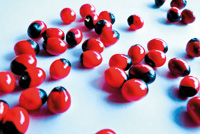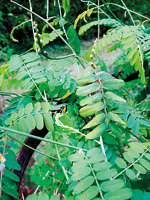 “Olinda thibenne koi koi dese, “Olinda thibenne koi koi dese,
Olinda thibenne Bangali dese..
Genath handanne koi koi dese,
Genath hadanne sinhala dese..”
This song heard during the Avurudu season over TV reminds us of the traditional Olinda Keliya (game), a firm favourite during the new year.
‘Olinda Keliya’ is a board game also known as Mancala games where a wooden board known as “Olinda Kolombuwa” or “Olinda Poruwa” which has several holes is used. The rules can differ from area to area, but the game is normally played by two players seated on either side of the board. On either side of the poruwa there are usually nine holes in which are placed four beads each. The beads are Olinda seeds that can be found in abundance in villages.
The players have to shift the beads from one hole to the other and collect the seeds found in the hole immediately after an empty one. Ultimately the player who could collect the largest amount of olinda beads becomes the winner of the game.

The Olinda vine |
The ‘Olinda Kolumbuwa’ also showcases the creativity of Sri Lankan traditional wood carvers. These boards are usually made of ebony (kaluwara) wood and beautifully carved. Most of these boards that are with families were designed during the Kandyan period. There is also a large collection of these boards in the Colombo Museum indicating how popular the game must have been in those days. ‘Olinda Keliya’ is also special, since it is mainly played by the women of the house while other traditional games are played mainly by men.
However, the most attractive element of this game is the shiny little red and black seed – Olinda. Crab's eye is its common English name while the seed is also known as Jequirity, Rosary Pea or Indian licorice. The scientific name is Abrus precatorius. Olinda is a slender creeper that can grow large if the conditions are right. The vine has long, pinnate-leafleted leaves.
The Olinda vine has small whitish, pink or purplish pea-shaped flowers that bloom in dense slightly elongated clusters. Individual flowers have five small green sepals, which are fused together at the base into a short tube as per botanical sources. The fruit is a flat and relatively broad pod (20-35 mm long and 12-15 mm wide) with a sharp point. These pods are sparsely covered in hairs and have a rough texture. But when mature, these brown pods split open and curl back to reveal several (usually 3-7) oval-shaped Olinda seeds. The very distinctive seeds are about 5-7 mm long and 4-5 mm wide. They are bright scarlet-red in colour with a large black spot. Smooth in texture and glossy in appearance, they generally remain on the plant for several months.
Olinda seeds in ancient time were used to measure gold. Olinda is an indigenous plant to Sri Lanka, but not endemic. Though it looks like a nut, the Olinda is also a legume like a pea or bean that splits into two with the seeds attached to one edge. They look beautiful, but many beautiful things can also be dangerous. “The Olinda seeds are also poisonous. They contain a toxin called abrin,” revealed Dr. Siril Wijesundara, head of Botanical Gardens Department. Abrin is deadly toxic, so it is always advisable to keep the attractive seeds away from children who may put them in their mouth.
“But the leaves have a sweet taste and are edible. Even the roots are not poisonous and used in medicine. The Olinda plant is a close relative of medicinal ‘wel mee’,” Dr. Wijesundara said. It grows fast and the birds disperse the seeds around. It can be an invasive in some parts. There is another species in this family called as ‘ela olinda’ - Abrus melanospermus, he adds. |

 “Olinda thibenne koi koi dese,
“Olinda thibenne koi koi dese, 
